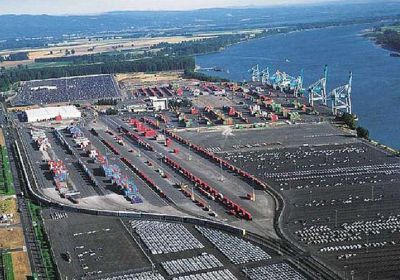
Work will begin this week on a $5 million upgrade at the International Marine Terminal in Portland, where operators say a pier expansion and improved container yard will help sustain recently rebooted container shipping at the site.
Executive Director John Henshaw of the Maine Port Authority said he’s busy visiting with companies in the state to convince them of the benefits of shipping through the terminal. Start-up shipper American Feeder Lines restarted large container shipping service to Portland last month, more than three and a half years since the Icelandic company Eimskip stopped calling on the city in late 2007.
While the previous 17 years of large container shipping service at the site proved there’s potential for that type of business on the waterfront, Henshaw acknowledged that capital investments like those beginning this week are necessary to prove to wary companies that the service is here to stay.
Large containers are 20- to 40-foot steel rectangular boxes carrying everything from raw materials to finished products for import and export.
“We knew there was freight that wanted to move between here and beyond Halifax,” Henshaw said, referencing the Canadian shipping hub through which American Feeder Lines moves its containers to an international market. “But obviously you’ve got to build some confidence that you’re here for the long haul. A company isn’t going to change their entire supply chain just because this new service popped up.”
The Maine Port Authority has leased the terminal from the city of Portland and operated it since 2009.
With $5 million in federal Department of Transportation grant money, the authority’s contractors this week will begin about a year of work expanding the pier by 5,000 square feet, demolishing at least two buildings and leveling the ground from the pier to Commercial Street.
The result will be a landscape upon which more, larger containers can be moved onto and off of ships and located in a place where they can be easily accessed by road by Maine companies using them.
Currently, four platforms that can hold 450 pounds per square foot connect the terminal yard with the pier, limiting the size and quantity of what can be loaded and unloaded from ships calling on Portland, the only American container shipping yard north of Boston. During the gap in service from late 2007 to mid-2011, companies that previously shipped through the terminal turned to train or truck to move their products and materials, Henshaw said.
The new pier expansion will create a single, wider connection to the terminal yard, with the strength to hold 1,000 pounds per square foot.
“We’ve actually had manufacturers’ representatives come in here and say, ‘We can’t get certain components in here,’ or, ‘We can, but we’ll need specialized equipment, and that’ll make [using this terminal] prohibitively expensive,’” Henshaw said.
With the extra space and weight, terminal workers will be able to not only handle heavier shipments but will be able to organize containers for easy loading onto the ship, which currently calls on Portland once a week.
“It’ll be a benefit,” said Jack Humeniuk, a local representative of the International Longshoremen’s Association, the labor union representing workers at the site. “It’ll make things more functional and more productive.”
Humeniuk said the work force at the terminal maintained steady numbers even during the gap in container shipping service there, as the site continued to be home to limited tug and tow barge operations. But he acknowledged that if the upcoming improvements trigger a boom in business, more jobs could be the result.
“We’re hoping we’re going to add more longshoremen because of an increase in business here,” said Henshaw. “Ultimately, I’d like to see 100 containers going in and 100 containers going out every week. We’re not quite there yet.”
He estimated the terminal currently sees between 30 and 50 containers moving through it each week. Construction work is slated to be finished by Aug. 30, 2012, and Henshaw said it will be orchestrated in such a way that does not interfere with regular operations there.
“The bigger picture is to allow a lot more Maine companies that participate in world markets to import and export more efficiently,” Humeniuk said. “That’s the higher benefit of investing in transportation infrastructure like this.”
By Seth Koenig (bangordailynews)
We use cookies to improve your experience. By continuing to use our site, you accept our Cookies, Privacy Policy,Terms and Conditions. Close X